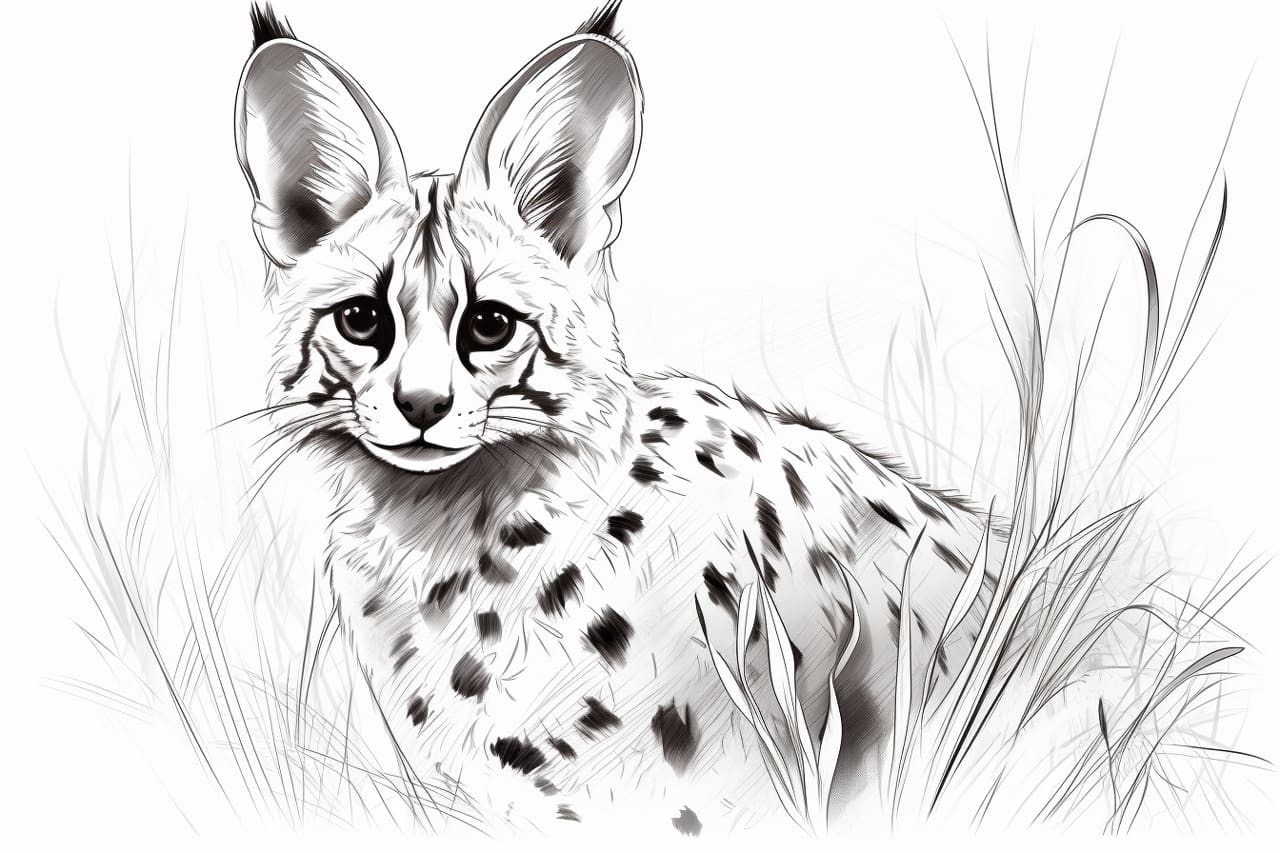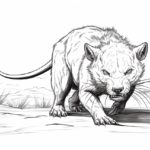Drawing Serval, with their striking coat pattern and graceful movements, is a captivating artistic challenge that allows you to explore the beauty of these fascinating creatures. Their distinctive long ears, slender limbs, and expressive eyes make them a unique subject for artists looking to capture the essence of the wild in their work. In this guide, we will delve into the techniques and tips for how to draw a Serval, from studying their anatomy to mastering their intricate markings. So grab your pencils and let’s embark on a creative journey to bring these magnificent animals to life on paper!
Materials Required
To draw a Serval, you will need the following materials:
- Drawing paper or sketchbook
- Pencils (varying in hardness from H to B)
- Eraser (kneaded eraser is recommended for precision erasing)
- Sharpener
- Colored pencils or markers (optional for adding color)
- Reference photo of a Serval for accuracy
- Ruler or straight edge (for creating straight lines or measuring proportions)
- Blending tools (such as blending stumps or tortillons) for shading and blending
- Fixative spray (optional, to set the drawing and prevent smudging):
How to Draw a Serval: a Step-by-step Guide
Step 1: Gather Your Materials
- Gather your drawing materials, including paper, pencil, eraser, and any preferred coloring tools such as colored pencils or markers.
Step 2: Study Reference Images
- Look up reference images of servals to understand their anatomy and features. Pay attention to their body proportions, facial details, and distinctive markings.
Step 3: Start with Basic Shapes
- Begin by lightly sketching basic shapes to outline the serval’s body. Use an oval for the head, elongated circles for the body and limbs, and triangles for the ears.
Step 4: Refine the Outline
- Refine the outline by adding more details to the body shape. Define the neck, shoulders, and hips to give the serval a more realistic form.
Step 5: Add Facial Features
- Sketch the facial features of the serval, including the eyes, nose, mouth, and whiskers. Pay attention to the almond-shaped eyes and the distinctive markings around the eyes and on the forehead.
Step 6: Draw the Ears and Tail
- Add the large, rounded ears with distinctive markings inside. Include the long, slender tail with a dark tip, characteristic of a serval.
Step 7: Add Details and Markings
- Add details such as fur texture, whiskers, and the intricate markings on the serval’s coat. Use short, quick strokes to create a realistic fur texture.
Step 8: Erase Guidelines
- Carefully erase any remaining guidelines and overlapping lines to clean up the drawing and make the serval’s features stand out.
Step 9: Color Your Drawing
- Choose appropriate colors to bring your serval drawing to life. Servals typically have a golden-yellow coat with black spots and stripes. Use a light touch and layer colors for depth and dimension.
Step 10: Final Touches
- Add any final touches, such as highlights to the eyes and fur, to enhance the overall appearance of your serval drawing. Take a step back to assess your drawing and make any necessary adjustments.
Step 11: Practice and Refine
- Practice drawing servals regularly to improve your skills and capture their unique characteristics more accurately. Experiment with different poses and expressions to expand your artistic abilities.
Conclusion
Congratulations on completing your drawing of a Serval! You have done a wonderful job capturing the grace and beauty of this majestic animal. Your attention to detail and use of shading have truly brought the Serval to life on the page. Remember to continue practicing and experimenting with different techniques to further enhance your skills as an artist. Keep up the great work and never stop pursuing your passion for art!
Fun Facts About Servals
Absolutely! Here are some fun and interesting facts about Servals:
- Servals are wild cats native to Africa, known for their slender bodies, long legs, and large ears.
- They are excellent hunters, with the ability to leap up to 10 feet in the air to catch birds in flight.
- Servals have the longest legs relative to body size of any cat species, which helps them navigate their grassland habitats and catch prey.
- They have a unique hunting technique called “shadow hunting,” where they use their large ears to pinpoint the exact location of prey hidden in the grass before pouncing.
- Servals are solitary animals and are most active during dawn and dusk, known as crepuscular hunters.
- Their coat features a beautiful golden-yellow background with black spots and stripes, which help them blend into their grassy habitats.
- Servals have a specialized hunting adaptation in their long necks, which allows them to reach into burrows and catch rodents.
- They are excellent swimmers and have been known to catch fish and frogs in the water.
- Servals communicate through a variety of vocalizations, including hisses, growls, and a unique high-pitched “scream” used for long-distance communication.
- Despite their wild nature, Servals have been bred with domestic cats to create a hybrid breed known as the Savannah cat, which combines the wild look of a Serval with the temperament of a domestic cat.
Suggestions for Scenes and Settings for Serval Drawings
Certainly! Here are some specific suggestions for scenes and settings for drawings of Serval:
- Serval in a Savanna: Draw Serval in their natural habitat, surrounded by tall grass, acacia trees, and a bright blue sky.
- Serval at Sunset: Capture the beauty of a Serval silhouetted against a stunning sunset sky, with warm orange and pink hues in the background.
- Serval in a Jungle: Illustrate Serval navigating through a lush, green jungle with dense foliage and colorful flowers.
- Serval by a Watering Hole: Show Serval taking a drink at a watering hole, with reflections of the surrounding trees and sky in the rippling water.
- Serval in Snow: Depict Serval in a winter wonderland, with snow-covered trees and a backdrop of snow-capped mountains.
- Serval in a Desert: Create a scene of Serval in a sandy desert landscape, with cacti, rocky outcrops, and a clear blue sky.
- Serval Resting in the Shade: Draw Serval lounging under a leafy tree, enjoying a moment of relaxation in the cool shade.
- Serval Hunting: Show Serval in action, stalking prey through tall grass or pouncing on their target with intense focus.
- Serval in a Tree: Capture Serval perched high in a tree, gazing out over the landscape below with curiosity and alertness.
- Serval Playtime: Illustrate Serval engaged in playful behavior, such as chasing butterflies, climbing rocks, or interacting with other animals.
Feel free to choose any of these suggestions as inspiration for your drawings of Serval, and have fun bringing these scenes to life with your artistic skills!









